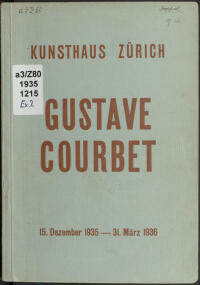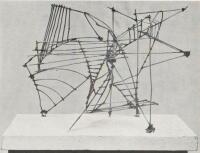Gustave Courbet
14.12.1935 – 31.03.1936
Location Kunsthaus.
Location Kunsthaus.
Solitary Artist and Fighter
The fate of Gustave Courbet, the main representative of French Realism, is closely bound up with with Switzerland. The “Maître d’Ornans” was born in the French Jura mountains in 1819, just a few kilometers from the Swiss border. In 1877 he died in La Tour-de-Peilz in the Vaud Canton, where he had been living in exile since 1873. Courbet fled to Switzerland after he had been made responsible as a member of the defeated Paris Commune for the destruction of Vendôme Column. He had been sentenced to six months in prison plus a fine after his release, so that he ultimately saw himself forced to leave his homeland for political and financial reasons.
In 1935-36 the Kunsthaus Zurich decided to install a Courbet exhibition. After the successful Corot Exhibition (1934) the exhibition under the patronage of the Federal President resembled a conspiracy of French-Swiss friendship in politically uncertain times. It encompassed major works from all the artist’s creative phases and genres, including « Les casseurs de pierre » (1849), “Les demoiselles des bords de la Seine” (1856/57) and « Le déjeuner de chass »e (1858). Probably the most spectacular of the roughly 140 works in the Kunsthaus was, however, the famous painting “Un enterrement à Ornans”: Courbet’s first large format painting, with the dimensions of an academic historical work, but showing really existing and unbeautified village people of Ornans, had caused a scandal in the Paris Salon in 1850.
The exhibition was discussed in detail in all parts of the country and in other parts of Europe. “It is the most educational exhibition for years,” wrote Heim und Leben and drew a general insight from it: “More trust in those artists who are courageous and well equipped to climb the steep path of the solitary!” The exhibition was also highly praised in the Journal de Genève and seen as a successor to that of Corot. The social-democratic daily, Volksrecht, greeted the fact that bourgeois Zurich had honored a fighter for socialism. The NZZ judged the exhibition very positively but could not stop itself from describing the artist as “spiritually rather primitive”; that was the only reason he had let himself be pulled towards social, satirical and anti-clerical themes. The suspicion that there were fake pictures in the exhibition also gave rise to much discussion.
[Peter Stohler]
Further information
Courbet fled to Switzerland after he had been made responsible as a member of the defeated Paris Commune for the destruction of Vendôme Column. He had been sentenced to six months in prison plus a fine after his release, so that he ultimately saw himself forced to leave his homeland for political and financial reasons.
108 days
1 Artist
1 Artist

1/3
exhibition catalog

2/3
exhibition catalog

3/3
exhibition catalog
1/3
